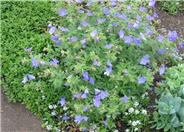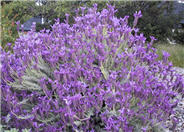
Common name:New Zealand Flax
Botanical name:Phormium tenax
New Zealand Flax is a large, bold plant with stiffly vertical, sword-like, green leaves that arise from its base. It should be grown under full sun for best color. Varieties will offer different growth habits and leaf color.

Common name:Common Yarrow, Milfoil
Botanical name:Achillea millefolium
Highlighting this perennial are spreading mats of fern-like rosettes, along with deeply divided leaves of a green or grey green color. In this form, the flowers are usually a white tone. Stems can reach 2-3ft above foliage. The yarrow propagates easily from rooted cuttings or division, which should be performed in the early spring or fall. Following bloom, one should dead head the plant and divide the clumps when it appears crowded.

Common name:Aeonium Succulent species
Botanical name:Aeonium species
These plants are one of the most useful succulents, due to their decorative effects and sculpturesque quality. The branched stems hold a wide rosetta of either light green or purple leaves. The flowers appear in long, clustered form. They need some shade in hotter areas. Prostrate forms are low-growing, and spreading.

Common name:Johnson's Blue Cranesbill
Botanical name:Geranium 'Johnson's Blue'
This herbaceous perennial is a favorite among geranium lovers. It grows up to 18" tall and 2'-3' wide. Saucer-like violet-blue flowers bloom from spring through fall. The leaves are bright green, finely cut and quite divided. Plant in full sun or half sun. Looks good in rock gardens, borders and containers.

Common name:Spanish Lavender
Botanical name:Lavandula stoechas
This dense shrub grows 2-3 ft. tall with blue gray foliage and deep purple flowers that have large showy bracts near the top of the spikes. It is drought tolerant . - Cornflower Farms

Common name:Wheeler's Dwarf Pittosporum
Botanical name:Pittosporum tobira 'Wheeler's Dwarf'
This handsome dwarf form of the Pittosporum tobira grows into a low, dense mound that is covered with glossy, evergreen foliage.

Common name:California Pepper, Mission Pepper
Botanical name:Schinus molle
The California Pepper is a fast-growing evegreen tree that will mature to a height of 25-40' and as wide. Its bright green leaves are divided into many narrow, 1 1/2-2" long leaflets. Naturalizes.

Common name:Strawberry Madrone, Marina Strawber
Botanical name:Arbutus 'Marina'
The 'Marina' has gorgeous bark, with leaves that are smaller and not as glossy as Pacific Madrone. Its flowers are pink, borne in pendant clusters in the summer. The fruit is large, red and quite ornamental. The plant should be grown in sun to part shade, with little or no summer watering when established. The 'Marina' prefers good drainage. -Monterey Bay Nursery

Common name:Yarrow Moonshine
Botanical name:Achillea 'Moonshine'
Pale yellow flowers appear to float on long, slender stems. Leaves are green to gray-green leaves, which are flatter and less divided than those of the Achillea millefolium. Yarrows propagate easily from rooted cuttings or division, which should be perfo Yarrows propagate easily from rooted cuttings or division, which should be performed in the early spring or fall. Following bloom, one should dead head the plant and divide the clumps when it appears crowded.
| Designer: Barbara Jackel Landscape Dsgn | Sitting Area and Walkway |
Photographer: GardenSoft |
Soils and Compost:
Incorporate compost 6" into your soil to retain water, reduce compaction, feed earthworms, and provide valuable nutrients to your plants.
Water Saving Tip:
Irrigate early in the morning and/or late in the evening to reduce water loss due to evaporation and wind drift.
Integrated Pest Management:
Drip and other smart irrigation delivers water directly to roots, allowing no excess water for weeds.

